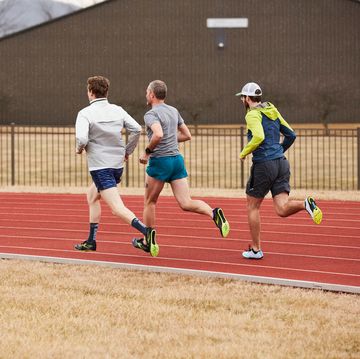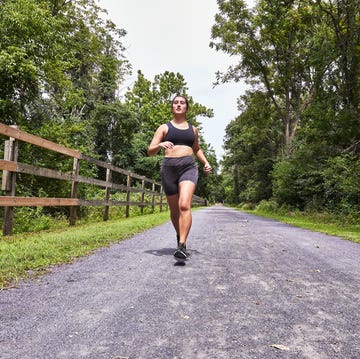It's fun to run fast. It starts with the cool, snug feel of a bare foot cinched up in a racing spike. As you drive your knees and pump your arms, your spikes grab the track, and a feeling of power overcomes you. You fly around the turn, and your hair is whipped back off your face. Tears stream from your eyes, partly due to the speed at which you're moving through the atmosphere--and partly from the joy you feel as your heart jumps inside you like something wild.
Okay, maybe that's a bit dramatic. But you get the point: It feels great to get the lead out. More importantly, running fast, at least once every few weeks, helps you become a speedier 5-K, 10-K, or even marathon runner.
So, how fast is fast? In this case, I'm not referring to speed sessions of 800 meters to mile repeats that are run at 5-K or 10-K race pace. Such longer interval sessions are certainly important to build strength and teach specific pace. But that's not really fast running. I'm talking about intervals no longer than 400 meters, and perhaps as short as 150 meters. And the speed of these repetitions is closer to 800-meter or mile race pace, with your intensity level reaching 95 percent of your maximum effort.
There are distinct physiological advantages to training faster than race pace. For instance, as blood lactate levels shoot skyward during each repetition, and stay elevated during the recovery in between, the body becomes better at buffering lactic acid. Running speedy intervals also stimulates fast-twitch muscle fibers, resulting in strength gains. And short, fast workouts develop neuromuscular coordination and enhance muscle recruiting patterns.
Perhaps the biggest benefit is the direct effect faster running has on your pace over longer distances. Overloading the body with fast workouts teaches it to adapt to speed. This makes marathon, 5-K, and 10-K pace easier to maintain.
The overall volume of high-intensity speed workouts should be relatively low, totaling only one to 21/2 miles. The length of your recovery between work intervals should be at least 2:1, or as long as 6:1 if needed. The real key is to feel rested enough to push hard on the next interval.
Always follow fast sessions with a couple of easy running days, because your muscles will be sore and your connective tissue will be strained. Ultimately, 5-K and 10-K runners only need such fast workouts once every two or three weeks. Marathoners are fine with one such workout per month. R
Best Fitness Trackers
Fun Half Marathons.
1) 10 x 400 meters at mile race pace with 90 seconds walk/jog recovery.
2) 2 sets of 3 x 300 meters starting at slightly slower than 800-meter race pace and dropping 2 seconds with each step down, so that the final 300 meters is faster than 800-meter race pace (example: 45 seconds, 43 seconds, 41 seconds). Recover 2 minutes between each 300 and 5 minutes between sets.
3) 3 to 4 x 400 meters at 800-meter pace with 4 to 5 minutes recovery, or longer if needed.

Watch Next

When Is the Best Time to Take a Look at Your GPS Watch

Advertisement - Continue Reading Below

What Exactly Is a Tempo Run?

When Is the Best Time to Take a Look at Your GPS Watch

5 Give A Gift
When Is the Best Time to Take a Look at Your GPS Watch
When Is the Best Time to Take a Look at Your GPS Watch



